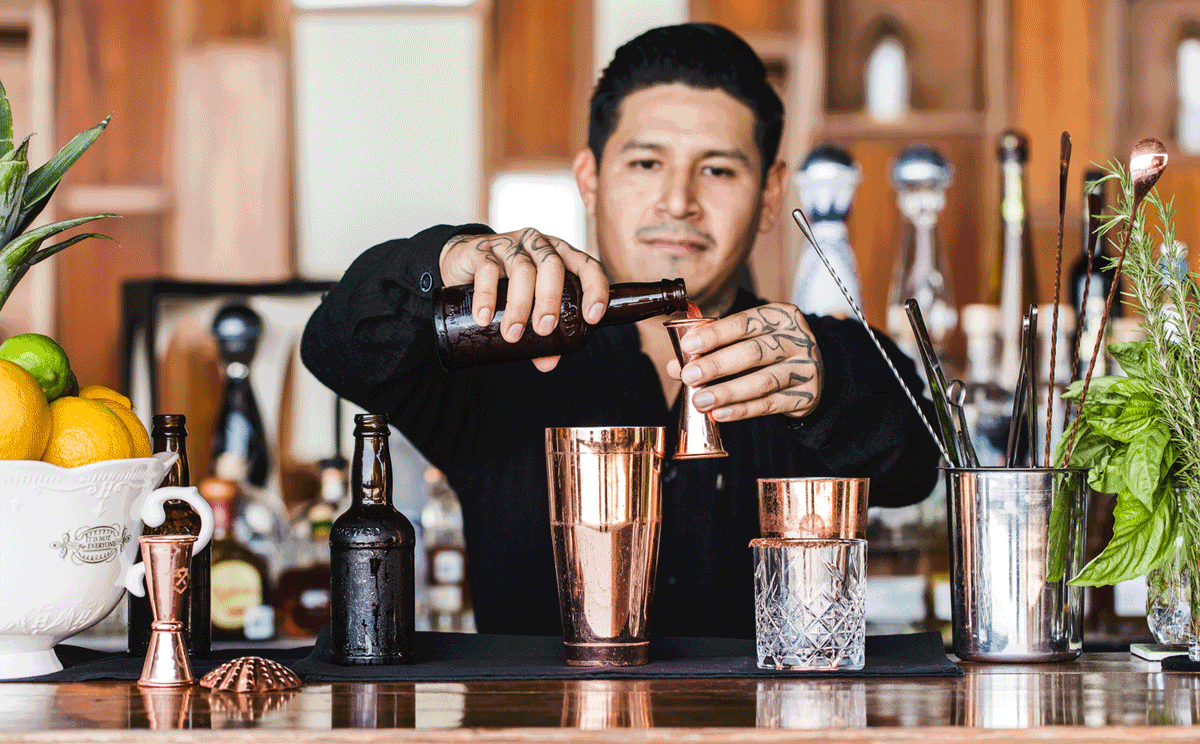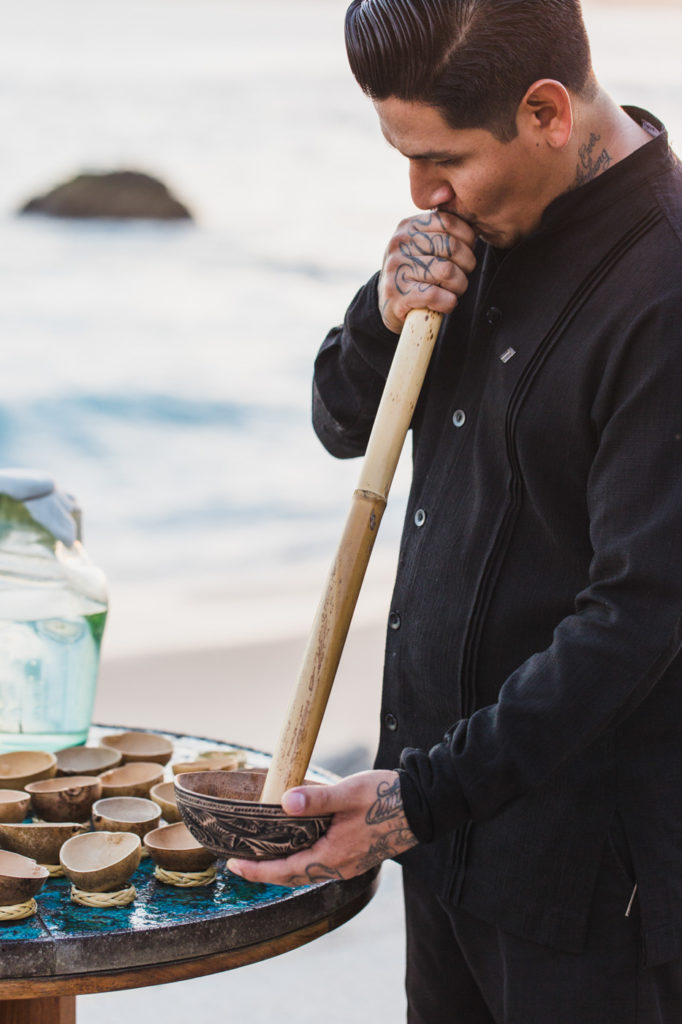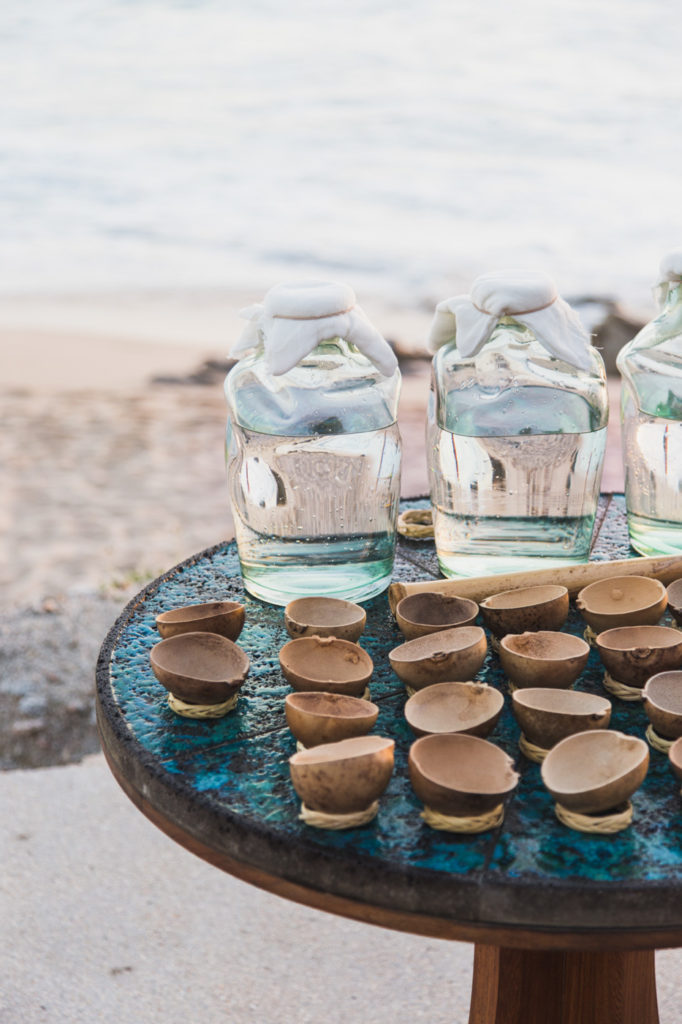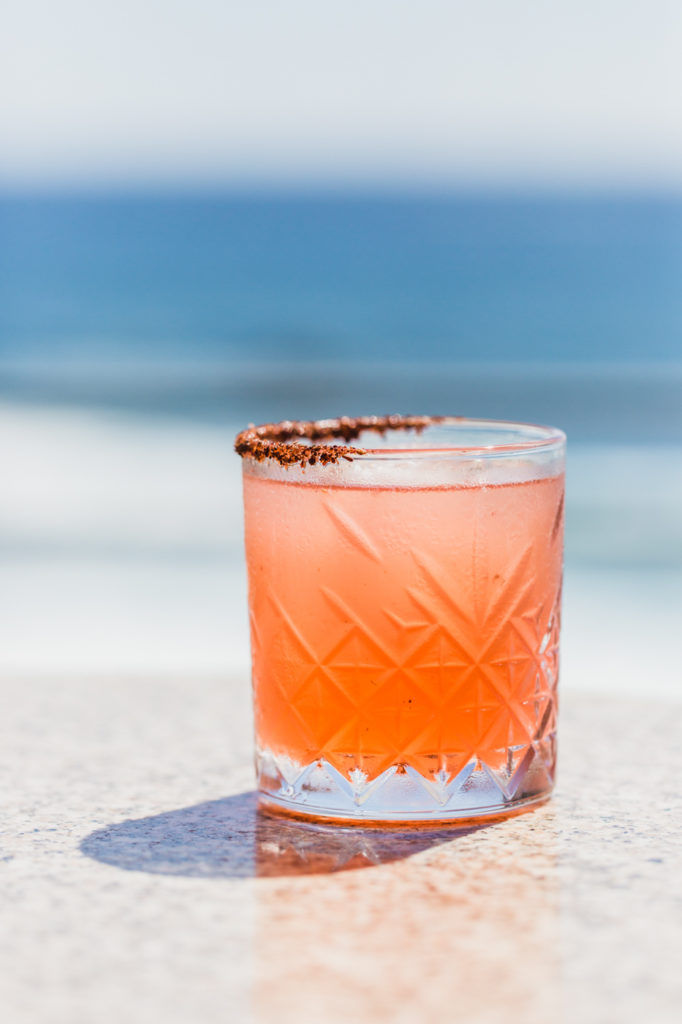Cocktails in Motion
Frida
In Cabo San Lucas, Mexico, Daniel Quezada, the in-house mezcalero for The Cape and cocktail developer for Manta, gives tips and a recipe for ultimate mezcal enjoyment.

When I met Daniel Quezada, the in-house mezcalero for The Cape in Cabo San Lucas and cocktail developer for Manta, decorated chef Enrique Olvera’s glassed-in restaurant overlooking a surfer’s paradise, the sun was setting over the Sea of Cortez, turning the large glass bottles of mezcal set out for our tasting a buttery pink. Beside the containers waited a tantalizing grid of jicara—small, shallow bowls made from the sun-dried skin of the jicaro fruit. Quezada filled each bowl by sucking mezcal part way through a wooden pipe and dispensing the liquid in a thin silver stream.
Venturing into most liquor stores in the States, you’d be hard pressed to find anything but Espadín—the only agave variety used for mezcal that is farmed. While that’s great for the cocktail recipe Quezada has provided (more on that below), there’s a certain pleasure derived from sipping something wild, unlabeled, unadorned and totally delicious. Each batch teases out the undertones of the environment—grassy, earthy, spicy, citrusy—alongside the characteristic smoke. The agave plant “is like a sponge,” Quezada says, soaking up whatever landscape in which it takes root. You taste the flowers; you taste the rocks.
A native to Oaxaca, the state with the highest production of the spirit, Quezada earned his title through relentless research, visiting pueblos, and developing relationships with traditional distillers. Sitting down with me, he offered a few tips and dispelled a few myths for drinking mezcal like a true Oaxacan.


Tip No. 1
Test the Alcohol the Traditional Way
“We serve [mezcal] in what’s called a jicara, and the process is called venenciar. The [serving] stick has two holes: one on the bottom, one at the top. We suck on the top hole and with our thumb we close it and let it pour into the jicara. The moment the mezcal starts pouring, it makes bubbles. If the bubbles stay, it’s good quality mezcal. It means it doesn’t have water, it doesn’t have chemicals, and the sugar became alcohol. If the bubbles don’t stay it could tell us [either] it’s not a good quality or the mezcal has a [high] percentage of alcohol.”
Tip No. 2
A Cocktail’s Best Friend
“For cocktails, the best mezcal anyone can use is Espadín, because we just want that smokiness. For example, if you use wild agave, [many of] those types of mezcal are meant to be drunk straight. Espadín is an agave that is easy to get, the flavors are neutral, and it tastes like mezcal is supposed to taste.”
Tip No. 3
You’re Drinking It Wrong
Many bars will serve mezcal alongside a selection of orange, chili salt, and occasionally crickets. Quezada explains what may seem like tradition is actually a marketing technique invented to compete with tequila. “It’s not right or wrong, but it’s not the traditional way. In the villages they’ll just serve you the mezcal with probably a glass of water; that’s it. They want you to taste the flavors, taste the difference. If you add something to your mouth, like an orange, it’s going to kill all the flavors that we’re looking for. Most [distillers] would take that as an insult, because it’s hard work to make mezcal.”
Tip No. 4
Buy Locally
“What we are trying to do at the restaurant is help the local producers. We want [the] money [to stay] in Oaxaca. The [mezcals] I like are the ones that are small batch that don’t have a big brand. Because they don’t have a label you won’t be able to find those in [North] America and Europe, only in the [Mexican] community. [The distillers] are not really interested in the fame or the money; they just want to keep making the process how their grandpa taught them.”
Tip No. 5
Timing Is Everything
Quezada loves to let the liquor speak for itself, letting it shine without food. He recommends drinking mezcal “before, by itself, or at the end of any meal.”

Frida Recipe
When developing the cocktails for Manta, Quezada drew inspiration from the cultures that inspired the cuisine. “We wanted to do something honest, [in keeping] with the philosophy of the restaurant,” he says. “We wanted to make a fusion between Japanese, Mexican and Oaxacan, and Peru. That’s why you see tequila, you see mezcal. We’re using sake, pisco.” For the Frida, he added fresh local watermelon and mint to a base of mezcal, as well as pisco to create a mixture both nuanced and refreshing, and the graduated rosy color of the Sea of Cortez sunset.
Ingredients:
— 1 oz. watermelon juice
— 1 oz. cranberry juice
— ¾ oz. Mezcal Espadín from Oaxaca
— ¾ oz. pisco
— ½ oz. lemon juice
— ¾ oz. mint syrup*
— Seasoning for rim**
*Mint Syrup: Mix 1 cup hot water, 1 cup sugar, and 75 grams fresh mint. Let steep until it reaches room temperature.
**Seasoned Rim: Chapulin and hibiscus salt as desired. A good substitute is Tajín seasoning.
Method:
Combine all ingredients, shake, and serve with ice in an old fashioned glass with seasoned rim.


Our comments section is for members only.
Join today to gain exclusive access.